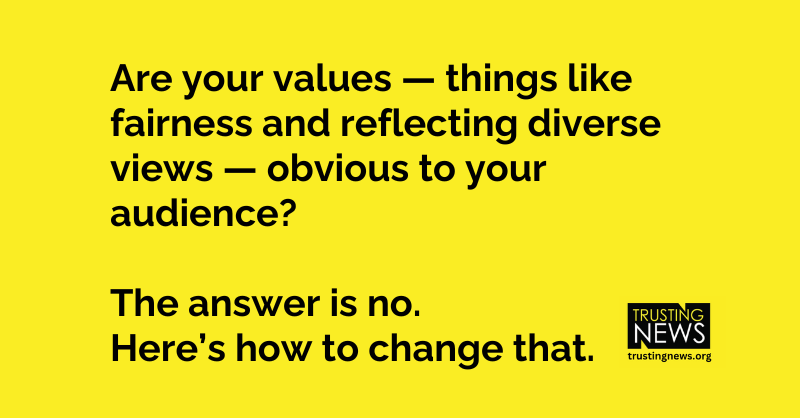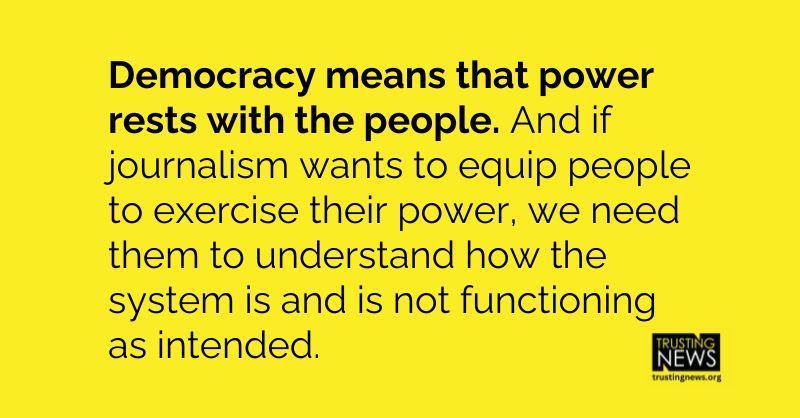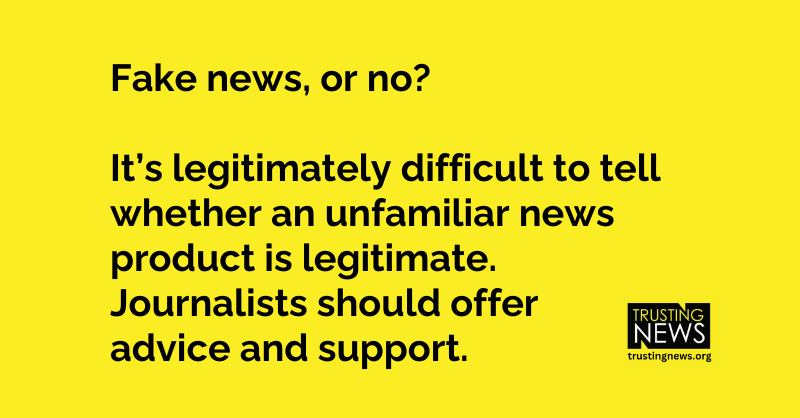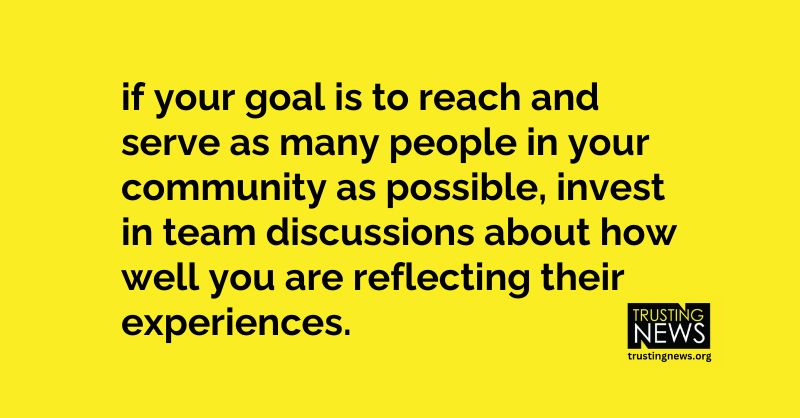
Don’t expect readers to click through to your mission statement or About Us page. Bring your ethics and integrity to life in your journalism.
Go further than these CBS and MSNBC values statements
Want to get this Trust Tips newsletter in your inbox each Tuesday? Subscribe here.
The news teams at MSNBC and CBS have both entered new chapters, and both have used the moment to get on the record about the values behind their work.
Readers, you know our team at Trusting News loves a good statement of values. It’s interesting to compare the two. It’s ALSO important to remember, as Laura Owen‘s insightful Nieman Journalism Lab piece reminded us, that most people will never read these principles. Most news consumers are not poking around journalists’ websites reading ethics policies and mission statements.
Please, let’s not pat ourselves on the back for the mere existence of documents like these. They should be table stakes — every news organization should be explaining in some form why they exist, how they operate, and what they commit to being held accountable for.
If we want to move the needle on trust — if we want people who consume our journalism to understand why we’re trustworthy — we need to be calling attention to these values day to day.
Let’s look at some examples from these two new values statements and then talk about what it would look like to make them visible.
How could these journalists commit to drawing attention to their values in their day-to-day work?
What do the statements say?
New editor Bari Weiss sent a memo to the CBS News team that laid out 10 core journalistic values, including things like:
- Journalism that is fair, fearless, and factual.
- Journalism that holds both American political parties to equal scrutiny.
- Journalism that embraces a wide spectrum of views and voices so that the audience can contend with the best arguments on all sides of a debate.
And Poynter covered a similar list of principles put out by leadership at MSNBC, including things like:
- Fairness: We report the news with an open mind. We aim to give the subject(s) of our original reporting an opportunity to comment before publication.
- Perspectives: We believe our audience is best served when our journalism reflects a variety of perspectives on the world we cover.
Read Owen’s Nieman piece for a thoughtful comparison of the two (including the astute observation that CBS focuses more on journalism as a product and MSNBC is framed around what happens internally).
How do journalists’ values show up in day-to-day coverage?
What matters to your audience is not what you say you believe when sitting around a conference room table. It’s how those principles play out day to day. It’s whether people feel good about the public service you claim to be offering.
Let’s start with the basic picture that both of these statements paint of journalism that “embraces a wide spectrum of views and voices” or “reflects a variety of perspectives.”
This is a concept that we so often take for granted as foundational to our work. But a lot of the public would disagree that we accomplish it — or even that we are aiming for it. One quick stat: Pew research found this summer that 58% of people would describe most journalists as “biased.” That can mean a lot of things and is a term worth unpacking or maybe even, for the bold, embracing! But when the *public* uses it, it’s usually a signal of a preference for some views over others or a slanted or unbalanced take on things. (Disclosure: I was an adviser on that Pew study.)
So, how do we draw attention to this part of our mission? How do we take it from generic mission statement to operational practice?
Across formats, it can be so, so simple.
When you’re talking directly to your audience, like in a video, a podcast or an author-driven newsletter, include language like this:
“This is a complex topic, and it’s important to us to accurately reflect how a lot of different people feel about it. That’s why we’re talking to x, y, and z.”
Or, with a bit more personality:
“It’s human nature to naturally empathize with one side or the other on issues like this. But as journalists, it’s our job to spend time understanding the different ways people experience and feel about this issue and to reflect their views accurately. We hope you’ll see we did that here, and you can read more about our values on our website.”
Sometimes when the audience notices the absence of balance in a story, it’s not for a lack of trying. I heard NPR CEO Katherine Maher say at ISOJ in April that NPR bookers had reached out more than 100 times to Trump administration officials over a several week period, and only twice had one of them come on air. Sonal Shah of The Texas Tribune followed up with the exact question I was sitting in the audience wishing she would ask: How would the public know that?
I know a lot of journalists are struggling these days to get right-leaning public officials to agree to an interview. And many stories will include language like “her office refused to comment” or “we reached out and have not heard back.” What if we got a lot more specific, such as:
“We know you’re eager to hear multiple viewpoints on this issue, and that includes the mayor’s office. We know from public statements the mayor has made that she believes x, y, and z about this, and we will continue looking for signs of how she plans to move forward. We have requested an interview this week by calling or emailing her office three times and by trying to talk to her after this week’s Council meeting. She has so far declined to talk to us, as she often has since she took office. That won’t stop us from asking.”
This works for regular people, too, not just public officials. If you’re having trouble getting people who feel a certain way about an issue to go on the record, try naming the tension.
“People who oppose the matter told us they don’t want their names associated with their views. They worry about public backlash and about being misunderstood. We understand that talking to a journalist can put people in a vulnerable spot, and we’re also committed to continuing to work hard to cover the range of views on this issue accurately and fairly. If you’re willing to be interviewed, please get in touch.”
(Related resource: A Trust Kit on earning trust with sources.)
Any of these statements could be made more formal, more concise or more detailed. They could become an editor’s note at the top of a story or a box next to a story online or in print. They could be adapted into a behind-the-scenes social media post, with swipe-through facts about how you operate. And when they’re in text format, be sure add a link at the end (“Read more about the values behind our work here”). See our Transparency Trust Kit for ideas of where to bake them in.
The basic idea is this: Anywhere your audience is learning about what you cover, think about what you wish they were also learning about how you operate.
At Trusting News, we learn how people decide what news to trust and turn that knowledge into actionable strategies for journalists. We train and empower journalists to take responsibility for demonstrating credibility and actively earning trust through transparency and engagement. Learn more about our work, vision and team. Subscribe to our Trust Tips newsletter. Follow us on Twitter, BlueSky and LinkedIn.

Executive Director Joy Mayer (she/her) founded Trusting News in 2016 after a 20-year career in newsrooms and teaching. She lives in Sarasota, Florida, and can be reached at joy@TrustingNews.org.



